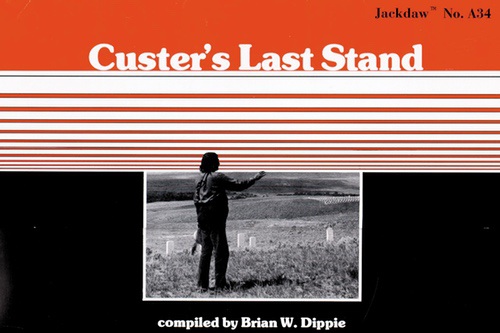
Custer's Last Stand
Custer's Last Stand, fought on June 25, 1876, is the most famous battle in the long history of the American Indian wars. It is also one of the least typical, since the Indians were the overwhelming victors that day, utterly destroying five companies of the Seventh U.S. Cavalry. Americans at the time, shocked though they were by the news of the disaster, chose to honor Custer and his men for their futile defense against a force of Sioux and Cheyenne along the Little Big Horn River in southeastern Montana. Not a soldier who fought with Custer that day lived to tell the story, and Custer's Last Stand quickly became a high point in the annals of American heroism. But Custer's Last Stand also became the center of controversy. Who was responsible for the disaster? The army blamed the civilian Bureau of Indian Affairs, and the Bureau blamed the army. Some contemporaries damned the Sioux as bloodthirsty savages, others saw the battle as the direct result of treaty violations and the government's shamefully inconsistent Indian policy. In the middle of the controversy, then and ever since, is the enigma of George Armstrong Custer himself. Was he a hero or villain, a gallant soldier or a foolish glory-hunter? This primary source portfolio provides some answers even as it raises other questions. Most of all, it sets Custer's Last Stand into is proper context as a historical and mythical event. This portfolio includes a Study Guide with reproducible student activities. 6 Illustrated Broadsheet Essays: * Treating with the Sioux * The Road to War * War with the Sioux * The Battle of the Little Big Horn * The Aftermath of Battle * The Custer Myth 11 Primary Source Documents: * The changing face of the Boy General, three portraits of George A. Custer, 1865, 1872, 1876 * A printed version of the Treaty of Fort Laramie and two pages of original treaty signatures, 1868 * Six pages from George A. Custer's My Life on the Plains, 1874 * Two letters from the Secretary of the Interior to the Secretary of War: December 3, 1875, and February 1, 1876, transcripts * Custer's last message to Captain F.W. Benteen, June 25, 1876 * Official map of the Custer Battlefield, 1876 * Telegram from General Alfred H. Terry to the Adjutant General of Military Division of the Missouri, June 27, 1876 * Telegram from R.C. Drum, Assistant Adjutant General, to H.T. Crosby, War Department, July 6, 1876, and a transcript * A letter from a survivor, Frederick F. Gerard, to his daughters * The Bismark, Dakota Territory, Tribune Extra, July 6, 1876: "First Account of the Custer Massacre" * "The Battle on the Little Big Horn River, The Death Struggle of General Custer," drawing in The Daily Graphic, July 18, 1876 * A political cartoon by Thomas Nast, Harper's Weekly, 1876








